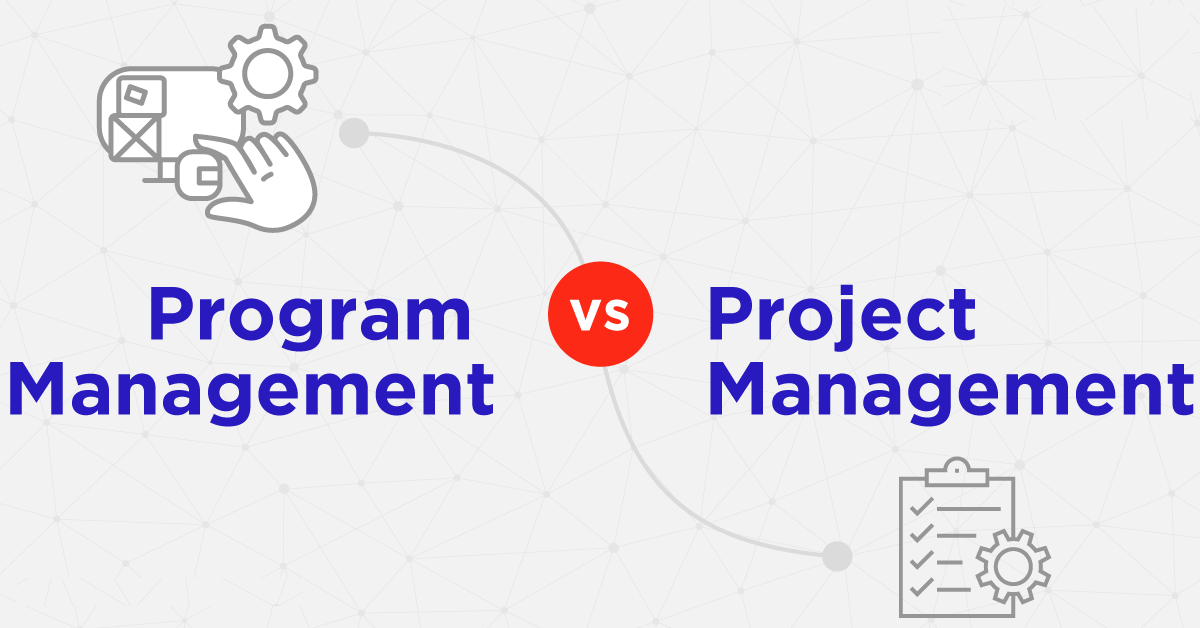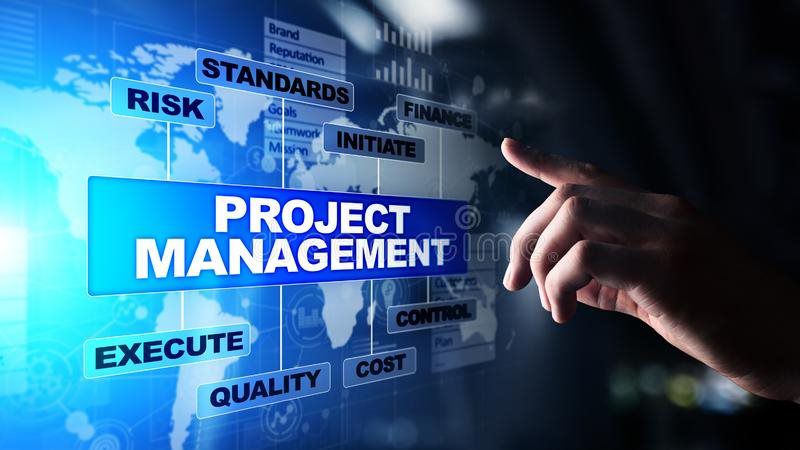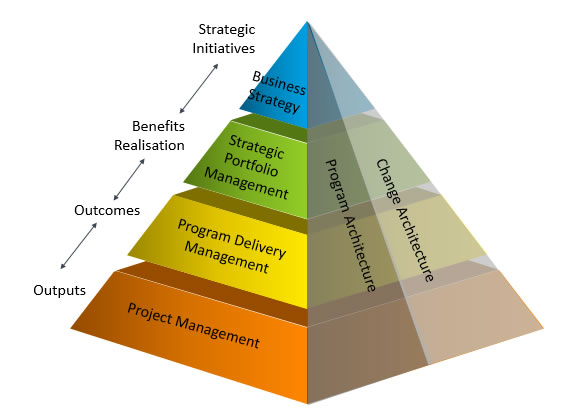Project & Program Management
Program and Project Management are two distinct but closely related disciplines that help organizations achieve their objectives efficiently and effectively. While both involve planning, executing, and monitoring work to achieve specific goals, they differ in scope, complexity, and focus.
Program Management
Definition: Program management involves overseeing multiple related projects that align with the organization’s strategic goals. A program is a collection of projects that work together to achieve broader organizational objectives.
Focus: Long-term outcomes and the strategic alignment of projects.
Scope: Broader and more complex, managing dependencies between projects.
Goal: Deliver benefits and value that support the organization’s long-term vision and objectives.
Role: The Program Manager oversees the coordination between multiple projects, ensuring alignment with business goals, managing risks across projects, and facilitating communication among stakeholders.
Project Management
Definition: Project management is the discipline of planning, executing, and closing a specific project to achieve predefined objectives. A project is a temporary endeavor with a defined beginning, end, scope, and resources.
Focus: Delivering specific deliverables within time, scope, and budget.
Scope: Narrower and more focused on individual tasks and milestones.
Goal: Achieve a defined objective (such as building a product or implementing a system).
Role: The Project Manager is responsible for managing the project's execution, controlling its scope, schedule, and cost, and ensuring that the project meets its specific goals.

Key differences between Program and Project Management
Program management follows a structured process that helps organizations deliver value from multiple projects that align with their strategic goals. Below are the key phases of program management:
a) Program Initiation
- Business Case Development: Defines why the program is necessary and the value it will deliver.
- Program Charter: A document that authorizes the program, outlines its objectives, and provides an overview of the program's components.
- Stakeholder Identification: Identify key stakeholders who will benefit from or be impacted by the program.
b) Program Planning
- Program Roadmap: A high-level view of all the projects and their timelines, deliverables, and interdependencies.
- Resource Planning: Determine the resources needed across projects, including human resources, budget, and technology.
- Risk Management Plan: Identify risks across projects and develop mitigation strategies.
c) Program Execution
- Project Coordination: Oversee the execution of individual projects to ensure they align with the program’s overall objectives.
- Resource Management: Allocate resources efficiently across projects, ensuring that dependencies are managed.
- Risk Management: Monitor and address risks that affect multiple projects.
d) Program Monitoring and Control
- Performance Tracking: Monitor progress across all projects, ensuring they align with the program goals and timeline.
- Change Management: Ensure changes to project scope or objectives are aligned with the overall program objectives.
- Reporting: Regularly report the program’s progress to stakeholders, including performance metrics, risks, and issues.
e) Program Closure
- Program Closeout Report: A final assessment of the program, including an evaluation of its success in delivering value and achieving objectives.
- Benefits Realization: Measure the long-term benefits and ensure they align with the organization’s strategic goals.
Key phases in the program management process
Project management involves a series of processes to ensure that a project meets its specific objectives. The key phases include:
a) Project Initiation
- Project Charter: A formal document that outlines the project’s purpose, goals, stakeholders, and resources.
- Stakeholder Identification: Identify all stakeholders involved in or affected by the project.
- Feasibility Study: Assess whether the project is viable and aligns with business goals.
b) Project Planning
- Project Scope Statement: Clearly define the project’s objectives, deliverables, and boundaries.
- Work Breakdown Structure (WBS): Break down the project into smaller, manageable tasks and activities.
- Schedule and Budget Planning: Develop a project timeline and allocate resources to ensure the project is completed on time and within budget.
- Risk Management Plan: Identify potential risks and develop strategies to mitigate them.
c) Project Execution
- Task Assignment: Assign tasks to team members and coordinate work to meet project milestones.
- Team Communication: Facilitate collaboration and communication within the project team.
- Stakeholder Management: Regularly update stakeholders on the project's progress.
d) Project Monitoring and Control
- Progress Tracking: Monitor the project’s progress against the plan using tools like Gantt charts or Kanban boards.
- Quality Control: Ensure that the project meets quality standards.
- Change Control: Manage changes in project scope, budget, or timeline.
- Performance Reporting: Provide regular updates on the project’s status to stakeholders.
e) Project Closure
- Project Handover: Deliver the final product or service to the client or end-users.
- Lessons Learned: Conduct a retrospective to document lessons learned and identify areas for improvement in future projects.
- Project Closeout Report: Document the project’s outcomes, final costs, and overall success.

Key phases in the project management process
Several methodologies and frameworks guide the execution of both programs and projects. Common methodologies include:
a) Waterfall
A linear approach, where each phase of the project must be completed before moving on to the next.
Best For: Projects with clearly defined objectives and scope, where changes are minimal.
b) Agile
An iterative and flexible methodology, often used for software development. It focuses on delivering small increments of a product through short development cycles (sprints).
Best For: Projects that require flexibility, where the scope may evolve over time.
c) Scrum (a subset of Agile)
Focuses on time-boxed iterations called sprints. A Scrum Master ensures adherence to the process, and the team delivers a working product at the end of each sprint.
Best For: Teams working on complex projects where collaboration and rapid feedback are key.
d) PRINCE2 (Projects IN Controlled Environments)
A structured project management methodology that emphasizes organization and control throughout the project lifecycle.
Best For: Large-scale projects with a focus on governance and accountability.
e) PMBOK (Project Management Body of Knowledge)
A set of standard guidelines and best practices provided by the Project Management Institute (PMI) for managing projects effectively.
Best For: Projects requiring a standard approach to planning, executing, and controlling activities.

Key methodologies for effective program and project management
a) Project Management Software
- Microsoft Project: A widely used tool for scheduling, resource management, and tracking project progress.
- Jira: Commonly used for Agile and Scrum projects, allowing teams to track tasks and sprints.
- Asana/Trello: User-friendly project management tools that allow teams to create tasks, assign work, and monitor progress.
b) Collaboration Tools
- Slack: A communication tool that facilitates real-time collaboration and communication within project teams.
- Microsoft Teams: An integrated platform for team collaboration, including chat, video conferencing, and file sharing.
c) Reporting and Analytics Tools
- Power BI/Tableau: Business intelligence tools that help visualize project data and performance metrics.
- Smartsheet: A platform for project planning, tracking, and automating workflows, with powerful reporting capabilities.
d) Resource Management Tools
- Float: A tool for managing project schedules and team availability, helping to balance workloads and resources.
- Wrike: A project management platform with resource management features, allowing teams to allocate and track resources across multiple projects.
Essential tools for effective program and project management
- a) Define Clear Goals and Objectives: Both programs and projects require clear, measurable goals and deliverables. Ensure that all stakeholders understand what success looks like.
- b) Maintain Strong Communication: Effective communication is key to ensuring alignment between team members, stakeholders, and leadership. Regular status updates and stakeholder meetings are critical.
- c) Risk Management: Anticipating risks and developing mitigation strategies is essential. Both program and project managers should continuously monitor risks and adjust plans accordingly.
- d) Monitor Progress and Performance: Use tools like dashboards, KPIs, and performance reports to track the status of both individual projects and overall program goals.
- e) Document Lessons Learned: At the conclusion of projects or programs, conduct a review to identify lessons learned and best practices that can be applied to future initiatives.
Key practices for successful program and project management
